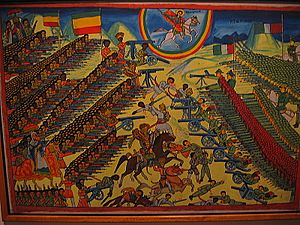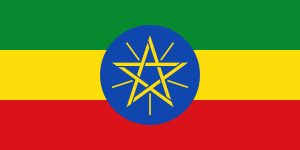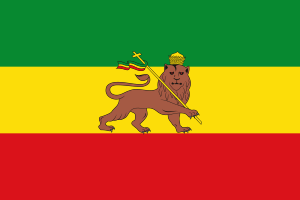Pan-Ethiopian nationalism facts for kids

Ethiopian nationalism (Amharic: ኢትዮጵያዊነት Ītyop'iyawīnet) also referred as Ethiopianism or Ethiopianness and Pan-Ethiopian nationalism, asserts that the people of Ethiopia/Ethiopians are a nation and promotes the cultural unity, whereas it defines ethnic groups have equality rights and constitute sovereignty. Ethiopian nationalism is a type of civic nationalism in that it is multi-ethnic and promotes diversity. The views espoused by Ethiopian nationalists is that, Ethiopian civic nationalism is in contrast to and in opposition against ethno-nationalist supremacy fueled by ethnic federalist policies in which Ethiopian nationalists claim that regional subdivisions of the state were segregated according to ethnicity brought about by the partitioning and dissolution of traditionally multi-ethnic regions causing the internal displacement of people through internal population transfers. However, there has been opposition to multi-ethnic Ethiopian nationalism from ethnic nationalist and separatists groups as seen in the surge of ethnic tensions between various Ethiopian ethnic groups and political parties most notably among the most populace ethnic groups in the country like the Amhara, Oromo, Somali, and Tigray peoples, most of whom who have separatist movements among their ranks, and conflict between Ethiopia and Eritrean Provincial Separatists vying for and later accomplishing the Independence of Eritrea (who had already formed their own region specific Eritrean Nationalism and national identity of the People of Eritrea / Eritreans having keen similarities to that of Ethiopian Nationalism because of its multi-ethnic nature) in the aftermath of the Amhara Political-Predominance Era that occurred towards the end of monarchic rule in the Ethiopian Empire. However, ethnic tensions surged between the Amhara, Oromo, Somali, and Tigray peoples, each of whom had formed separatist movements dedicated to leaving Ethiopia.
History and Development

The conception of an Ethiopian nation by Ethiopian nationalists is stated to have begun with the Aksumite Kingdom in the 4th century A.D. The Aksumite Kingdom was a predominantly Christian state that at the height of its power controlled what is now the Ethiopian Highlands, Eritrea, and the coastal regions of Southern Arabia. The Aksumite Kingdom was responsible for the development of the religious movement that became the Ethiopian Orthodox Tewahedo Church. However, the expansion of Islam in the 7th century caused the decline of the Aksumite Kingdom, and most of the lowland populations converted to Islam, while the highland people remained Christian. Since the Aksumite people became divided between Christian highlands and Islamic lowlands, religious and tribal tensions and rivalries between the people intensified. The Aksumite society changed into a loose confederation of city-states that maintained the language of Aksum.
After the fall of Aksum due to declining sea trade from fierce competition by Muslims and changing climate, the power base of the kingdom migrated south and shifted its capital to Kubar (near Agew). They moved southwards because, even though the Axumite Kingdom welcomed and protected the companions of Prophet Muhammad to Ethiopia, who came as refugees to escape the persecution of the ruling families of Mecca and earned the friendship and respect of the Prophet. Their friendship deteriorated when South-Arabians invaded the Dahlak islands through the port of Adulis and destroyed it, which was the economic backbone for the prosperous Aksumite Kingdom. After a second golden age in the early 6th century the Aksumite empire began to decline in the mid 6th century, eventually ceasing its production of coins in the early 7th century. Around this same time, the Aksumite population was forced to go farther inland to the highlands for protection, abandoning Aksum as the capital. Arab writers of the time continued to describe Ethiopia (no longer referred to as Aksum) as an extensive and powerful state, though they had lost control of most of the coast and their tributaries. While land was lost in the north, it was gained in the south; and, though Ethiopia was no longer an economic power, it still attracted Arab merchants. The capital was moved to a new location, currently unknown, though it may have been called Ku'bar or Jarmi.
Under the reign of Degna Djan, during the 10th century, the empire kept expanding south, and sent troops into the modern-day region of Kaffa, while at the same time undertaking missionary activity into Angot and Amhara.
Local history holds that, around 960, a Jewish Queen named Yodit (Judith) or "Gudit" defeated the empire and burned its churches and literature. While there is evidence of churches being burned and an invasion around this time, her existence has been questioned by some western authors. Another possibility is that the Aksumite power was ended by a southern pagan queen named Bani al-Hamwiyah, possibly of the tribe al-Damutah or Damoti of the Sidama people. It is clear from contemporary sources that a female usurper did indeed rule the country at this time, and that her reign ended some time before 1003. After a short Dark Age, the Aksumite Empire was succeeded by the Agaw Zagwe dynasty in the 11th or 12th century (most likely around 1137), although limited in size and scope. However, Yekuno Amlak, who killed the last Zagwe king and founded the modern Solomonic dynasty around 1270 traced his ancestry and his right to rule from the last emperor of Aksum, Dil Na'od. It should be mentioned that the end of the Aksumite Empire didn't mean the end of Aksumite culture and traditions; for example, the architecture of the Zagwe dynasty at Lalibela and Yemrehana Krestos Church shows heavy Aksumite influence.
Fearing of what recently occurred, Axum shifted its capital near Agew In the middle of the sixteenth century Adal Sultanate armies led by Harar leader Ahmed Gragn invaded the Ethiopian Highlands in what is known as the "Conquest of Habasha". Following Gragn invasions the southern part of the Empire was lost to Ethiopia and scattered several groups like the Gurage people were cut off from the rest of Abyssinia. In the late sixteenth century the nomadic Oromo people penetrated the Abyssinian plains occupying large territories during the Oromo migrations. Abyssinian warlords often competed with each other for dominance of the realm. The Amharas seemed to gain the upper hand with the accession of Yekuno Amlak of Ancient Bete Amhara in 1270, after defeating the Agaw lords of Lasta.
The Gondarian dynasty, which since the 16th century had become the centre of Royal pomp and ceremony of Abyssinia, finally lost its influence as a result of the emergence of powerful regional lords, following the murder of Iyasu I, also known as Iyasu the Great. The decline in the prestige of the dynasty led to the semi-anarchic era of Zemene Mesafint ("Era of the Princes"), in which rival warlords fought for power and the Yejju Oromo እንደራሴ enderases ("regents") had effective control. The emperors were considered to be figureheads. Until a young man named Kassa Haile Giorgis also known as Emperor Tewodros brought end to Zemene Mesafint by defeating all his rivals and took the throne in 1855. The Tigrayans made only a brief return to the throne in the person of Yohannes IV in 1872, whose death in 1889 resulted in the power base shifting back to the dominant Amharic-speaking elite prior to Yejju Oromo and Tigrayan rule. His successor Menelik II an Emperor of Amhara origin seized power. League of Nations in 1935 reported that after the invasion of Menelik's forces into non Abyssinian-proper lands of Somalis, Harari, Southern Oromo, Sidama, Shanqella etc, the inhabitants were enslaved and heavily taxed by the gebbar-feudal system leading to depopulation.
Some scholars consider the Amhara to have been Ethiopia's ruling elite for centuries, represented by the Solomonic line of Emperors ending in Haile Selassie I. Marcos Lemma and other scholars dispute the accuracy of such a statement, arguing that other ethnic groups have always been active in the country's politics. This confusion may largely stem from the mislabeling of all Amharic-speakers as "Amhara" even though they were from a different ethnic group, and the fact that many people from other ethnic groups have adopted Amharic names. Another is the claim that most Ethiopians can trace their ancestry to multiple ethnic groups, including the last self-proclaimed emperor Haile Selassie I and his Empress Itege Menen Asfaw of Ambassel of having both Amhara and Oromo linage.
Oromo migrations, occurred with the movement of a large pastoral population from the southeastern provinces of the Empire. A contemporary account was recorded by the monk Abba Bahrey, from the Gamo region. Subsequently, the empire organization changed progressively, with faraway provinces taking more independence. A remote province such as Bale is last recorded paying tribute to the imperial throne during Yaqob reign (1590-1607).
By 1607, Oromos were also major players in the imperial politics, when Susenyos I, raised by a clan through gudifacha (or adoption), took power. He was helped by fellow Luba age-group generals Mecha, Yilma and Densa, who were rewarded by Rist feudal lands, in the present-day Gojjam districts of the same name.
The reign of Iyasu I the Great (1682-1706) was a major period of consolidation. It also saw the dispatching of embassies to Louis XIV's France and to Dutch India. During the reign of Iyasu II (1730-1755), the Empire was strong enough to undertake a war on the Sennar Sultanate, where the emperor leading its army to Sennar itself, was afterwards forced to retreat upon defeat along the Setit river. Iyasu II also conferred the dignity of Kantibai of the Habab (northern Eritrea) after homage by a new dynasty.
The Wallo and Yejju clans of the Oromo people rise to power culminated in 1755, when Emperor Iyoas I ascended to the imperial throne in Gondar. They would be one of the major factions contending for imperial power during the ensuing Zemene Mesafint, starting from 1769, when Mikael Sehul, Ras of Tigray killed Iyoas I and replaced him with Yohannes II.
The establishment of modern Ethiopia was led by the Shawan people (which included both Amharas and Oromos), particularly Amhara emperors Tewodros II of Gondar, who governed from 1855 to 1868, Yohannis IV, who was from Tigray governed from 1869 to 1889 and managed to expand his authority into Eritrea, and Menelik II, who governed from 1889 to 1913 and repelled the Italian invasion of 1896.
From 1874 to 1876, the Empire, under Yohannes IV, won the Ethiopian-Egyptian War, decisively beating the invading forces at the Battle of Gundet, in Hamasien province (in modern day Eritrea). In 1887 Menelik king of Shewa invaded the Emirate of Harar after his victory at the Battle of Chelenqo.
Beginning in the 1890s, under the reign of the Emperor Menelik II, the empire's forces set off from the central province of Shoa to incorporate through conquest inhabited lands to the west, east and south of its realm. The territories that were annexed included those of the Western Oromo (non-Shawan Oromo), Sidama, Gurage, Wolayta, and Dizi. Among the imperial troops was Ras Gobena's Shewan Oromo militia. Many of the lands that they annexed had never been under the empire's rule, with the newly incorporated territories resulting in the modern borders of Ethiopia.
Ethiopia, unlike the rest of Africa, had never been colonized. Ethiopia was accepted as the first independent African-governed state at the League of Nations in 1922. Ethiopia was occupied by Italy after the Second Italo-Abyssinian War, but it was liberated by the Allies during World War II.
After the war, Ethiopia annexed Eritrea. However, ethnic tensions surged between the Amhara and the various ethnic groups of Eritrea, as well as Oromo, Somali, and Tigray peoples, in Ethiopia proper, each of whom had formed separatist movements dedicated to leaving Ethiopia. After the overthrow of the Ethiopian monarchy by the Derg military junta, the country became aligned with the Soviet Union and Cuba after the United States failed to support it in its military struggle with Somali separatists in the Ogaden region. After the end of military government in Ethiopia in 1993, Eritrea separated from Ethiopia.
Legacy of independence
In March 1896 a definitive battle took place between the forces of colonial Italy, and those of the Ethiopian Empire in a town in northern Ethiopia called Adwa. The battle was short but extremely violent with tens of thousands of deaths. At the time Emperor Menelik II of Ethiopia had mobilized the Ethiopian people regardless of class and ethnicities. The mobilization drive would see millions of Ethiopian Citizens march from their towns, villages, and cities into the Northern Highlands for the preservation of their African Empire. This battle would end in a decisive victory for Ethiopia, marking the country with a unique legacy of independence in the face of European Aggression.
The battle of Adwa is the foundation for Ethiopian Nationalist ideology. For many Ethiopians, the threat of foreign invasion is the rallying cry for patriotic sacrifices and nationalist ideologues. By the time the battle of Adwa took place almost all of Africa was dominated by European forces. Ethiopian independence broke the mold of European superiority & provided a beacon of hope for black nations and peoples around the world. For many Ethiopians this moment represents a transitional moment, in which the nation realized its teleological doctrine. While the first war against Italy was a uniting war, the 1934 invasion by Benito Mussolini was extremely divisive. In Observation on the Ethiopian Nation Charles McClellan argues that the Italo-Abyssinian war of 1934 was in fact "as much a civil war as one against foreign aggression." McClellan argues that the political and factional differences which emerged in Ethiopia prior to the war, were not resolved by the Italian invasion but instead were amplified. This in the authors opinion led to an era of bitter factionalism which would "define the dynamics of post-war Ethiopian politics."
Era of ethnic federalism

Since 1992 prior to the appointment of Abiy Ahmed as Prime Minister the TPLF has had almost complete control of the government leveraging its power to concentrate wealth and development into the Tigray Region. The hegemonic rule of the Tigray people in Ethiopia was in many ways a reaction to the predominance Amharas had in media and governance. The hegemonic rule of a few ethnic groups or in some cases a single ethnic group has marginalized many groups within Ethiopia and has led to a cycle of violence and retribution. In the early 1990s the TPLF believed that through an ethnic federalist state system, one in which regions were assigned and divided by ethnic population, they could
"reduc[e] the inter-ethnic conflict that has divided Ethiopian society for centuries; (2) promot[e] equitable material conditions in all areas of the country; and (3) improv[e] the efficiency and effectiveness of public sector performance at the field level. They argued they could use political and administrative devolution to promote these objectives without threatening other important objectives, such as economic growth and political stability."
While these region weren't given "extensive sub-national control over technical policies, laws, regulations, and tax" their creation lent credibility to the different independence and ethnic nationalist movements around the country. For Ethiopian Nationalists, this credibility has emboldened different groups, giving them more cohesion, whilst corroding national unity and notions of Pan-Ethiopianism. The increased autonomy of these groups contrasted with the increased repression by Tigray elites created a situation in which the ruling class was both empowering groups through greater ethnic cohesion, but transparently stifling their political will. As evidenced by the 2005 elections the TPLF use of violent repression to subdue detractors of the ruling coalition only had the effect of radicalizing ethnic parties and increasing ethnic divisions. Many Ethiopian nationalists view the system of ethnic federalism as having made governing in Ethiopia a zero sum game. To win power in Ethiopia is to deny any other ethnic group significant power. By expelling notions of Ethiopianism or multi-ethnic Ethiopian national identity from the national political dialogue the TPLF has increased the ethnic cleavages and created a system revolving around ethnic affiliation, void of political ideology. In 2015 "after a master plan was unveiled to expand the boundaries of the capital, Addis Ababa" into Oromia thousands of Oromo Youth Liberation Movement Members took up to the streets demanding increased political representation, an end to the TPLF sponsored Master Plan, and avenues of dissent. Although the ruling party tried to blunt these protests through physical force they only grew and Amharas "angered by an unfulfilled demand to retake control of some of their lands" launched protests of mostly Oromos and Amharas (but also other Ethiopians) demanding proportional political representation and influence. After a 10-month state of emergency imposed by the TPLF, which saw the abdication of prime minister Hailemariam Desalegn, Abiy Amhed was selected by the ruling EPDRF coalition as the next prime minister due to his mixed Oromo-Amhara ethnic ancestry with a preference to his Oromo identify. Since taking power he has taken up major reforms allowing back political dissidents, releasing some political prisoners, and liberalizing the economy. While his drive to reform and democratize the nation have garnered him support across the country he still has not addressed the fundamental issues of the Ethnic Federalist system, which in the Pan-Ethiopians' opinion is the root cause for ethno-nationalist politics and tensions. Ethiopian nationalists believe that Ethnic Federalism must be ended to shift Ethiopian politics from ethnic patronage to ideology, it must be ended to induce national cohesion and blunt sectarian loyalty, and through the blunting of ethnic cohesion induce an era of unity and prosperity.
See also
- Ethiopianism


